
Ralph Johnson Bunche was an American political scientist, diplomat, and leading actor in the mid-20th-century decolonization process and US civil rights movement, who received the 1950 Nobel Peace Prize for his late 1940s mediation in Israel. He is the first black Nobel laureate and the first person of African descent to be awarded a Nobel Prize. He was involved in the formation and early administration of the United Nations (UN), and played a major role in both the decolonization process and numerous UN peacekeeping operations.

Logan Circle is a historic roundabout park and neighborhood of Washington, D.C., located in Northwest D.C. The majority of Logan Circle is primarily residential, except for the highly-commercialized 14th Street corridor that passes through the western part of the neighborhood. In the 21st century, Logan Circle has been the focus of urban redevelopment and become one of Washington's most expensive neighborhoods. Today, Logan Circle is also one of D.C.'s most prominent gay neighborhoods.
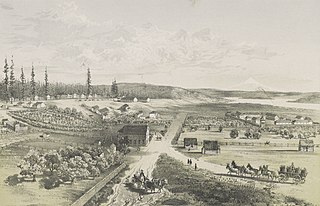
Fort Vancouver National Historic Site is a United States National Historic Site located in the states of Washington and Oregon. The National Historic Site consists of two units, one located on the site of Fort Vancouver in modern-day Vancouver, Washington; the other being the former residence of John McLoughlin in Oregon City, Oregon. The two sites were separately given national historic designation in the 1940s. The Fort Vancouver unit was designated a National Historic Site in 1961, and was combined with the McLoughlin House into a unit in 2003.

George Washington Carver National Monument is a unit of the National Park Service in Newton County, Missouri. The national monument was founded on July 14, 1943, by Franklin Delano Roosevelt, who dedicated $30,000 to the monument. It was the first national monument dedicated to an African American and first to a non-president.

LeDroit Park is a neighborhood in Washington, D.C. located immediately southeast of Howard University. Its borders include Florida Avenue NW, Bryant Street NW, Georgia Avenue NW, and 2nd Street NW .LeDroit Park is known for its history and 19th century protected architecture. The community's diversity entices new residents to the community, as well as its close proximity to the Shaw–Howard University Metro station and many dining options.
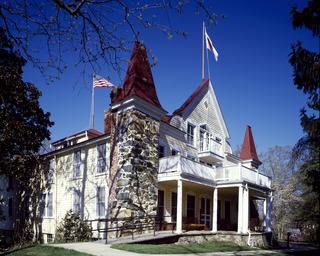
The Clara Barton National Historic Site, which includes the Clara Barton House, was established in 1974 to interpret the life of Clara Barton (1821–1912), an American pioneer teacher, nurse, and humanitarian who was the founder of the American Red Cross. The site is located 2 miles (3.2 km) northwest of Washington D.C. in Glen Echo, Maryland.

President's Park, located in Downtown Washington, D.C., encompasses the White House and includes the Eisenhower Executive Office Building, the Treasury Building, and grounds; the White House Visitor Center; Lafayette Square; and The Ellipse. President's Park was the original name of Lafayette Square.

Saint-Gaudens National Historical Park in Cornish, New Hampshire, preserves the home, gardens, and studios of Augustus Saint-Gaudens (1848–1907), one of America's foremost sculptors. The house and grounds of the National Historic Site served as his summer residence from 1885 to 1897, his permanent home from 1900 until his death in 1907, and the center of the Cornish Art Colony. There are three hiking trails that explore the park's natural areas. Original sculptures are on exhibit, along with reproductions of his greatest masterpieces. It is located on Saint-Gaudens Road in Cornish, 0.5 miles (0.80 km) off New Hampshire Route 12A.

The Woodrow Wilson House was the residence of the 28th president of the United States, Woodrow Wilson after he left office. It is at 2340 S Street NW just off Washington, D.C.'s Embassy Row. On February 3, 1924, Wilson died in an upstairs bedroom. It was designated a National Historic Landmark in 1964. The National Trust for Historic Preservation owns the house and operates it as a museum.
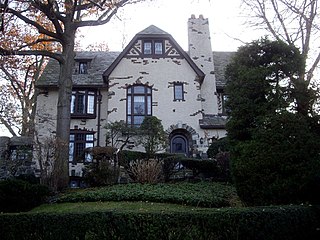
Ralph Johnson Bunche House, the last home of American diplomat Ralph Bunche (1903–1971), is a National Historic Landmark in New York City. It is a single-family home built in 1927 in the neo-Tudor style, and is located at 115–24 Grosvenor Road, Kew Gardens, Queens. It is named after Ralph Bunche, who helped to found the United Nations in 1945. In 1950, he became the first African American and first person of color to win the Nobel Peace Prize, for mediating armistice agreements between Israel and its neighboring countries.

Harriet Tubman National Historical Park is a US historical park in Auburn and Fleming, New York. Associated with the life of Harriet Tubman, it has three properties: the Harriet Tubman Home for the Aged, in Auburn; the nearby Harriet Tubman Residence, just across the city/town line in Fleming; and the Thompson A.M.E. Zion Church and parsonage in Auburn. They are located at 180 and 182 South Street and 47–49 Parker Street, respectively. The A.M.E. Zion Church unit is administered by the National Park Service (NPS), and the South Street properties, including a historic barn and a visitor center, are jointly managed and operated by both the NPS and the Harriet Tubman Home, Inc. The church also works with the NPS in park operations. The Harriet Tubman Grave, in nearby Fort Hill Cemetery, is not part of the park.
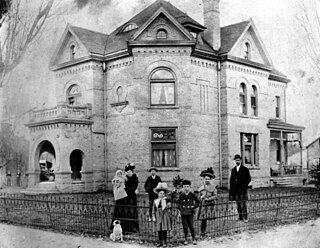
The Reed Smoot House, also known as Mrs. Harlow E. Smoot House, was the home of Reed Smoot from 1892 to his death in 1941, and is located at 183 E. 100 South, Provo, Utah, United States. Smoot was a prominent US Senator best known for advocacy of protectionism and the Smoot–Hawley Tariff Act.

Newton D. Baker House, also known as Jacqueline Kennedy House, is a historic house at 3017 N Street NW in Washington, D.C. Built in 1794, it was home of Newton D. Baker, who was Secretary of War, during 1916–1920, while "he presided over America's mass mobilization of men and material in World War I. After the assassination of president John F. Kennedy in 1963, Jacqueline Kennedy purchased the house and lived here for about a year.

The David White House is a historic house at 1459 Girard Street NW in Washington, D.C. A National Historic Landmark, it was the home of geologist David White (1862–1935) from 1910 to 1925. White had a longtime association with the United States Geological Survey (USGS), and performed groundbreaking research on peat and petroleum geology.

Ralph J. Bunche House, also known as the Ralph Bunche Peace & Heritage Center and located in South Los Angeles, United States, was the Victorian-Bungalow style boyhood home of Nobel Peace Prize winner Ralph Bunche. It was declared a Los Angeles Historic-Cultural Monument by the Los Angeles Cultural Heritage Commission in 1976, and it was listed on the National Register of Historic Places in 1978.
Ralph Bunche House may refer to:

Brooks Mansion is a Greek Revival plantation house and Category II Landmark owned by the District of Columbia government. It is located at 901 Newton Street, Northeast, Washington, D.C., in the Brookland neighborhood, next to the Brookland–CUA.
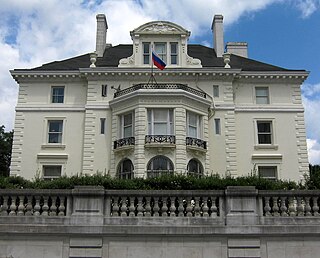
The Lothrop Mansion, also known as the Alvin Mason Lothrop House, is an historic home, located at 2001 Connecticut Avenue, Northwest, Washington, D.C., in the Kalorama Triangle neighborhood.

The Alma Thomas House is an historic house, located at 1530 15th Street, N.W., in the Logan Circle neighborhood.




















